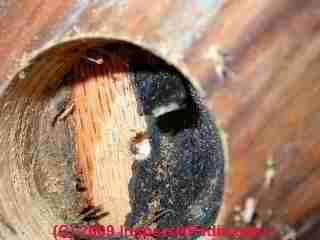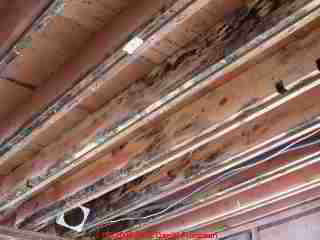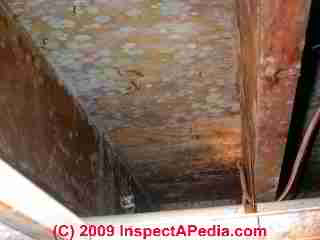 Hidden or Trapped Mold in Building Framing or Sheathing
Hidden or Trapped Mold in Building Framing or Sheathing
What to Do About Trapped Mold Growth or Spore Contamination in Buildings
- POST a QUESTION or COMMENT about mold traps: mold that may be hidden between layers of building materials
How to find hidden mold in buildings: trapped mold between building surfaces or materials.
The fact that mold is "hidden" in buildings does not mean one cannot find it. We look by context: where do we see leak stains, or where do we see building practices most likely to have produced a hidden leak or moisture problem?
Ice dam leaks in walls, hidden plumbing leaks, roof spillage by the foundation, are all common clues that often track to a wet building wall or ceiling cavity and from there to a hidden mold problem which may need to be addressed.
InspectAPedia tolerates no conflicts of interest. We have no relationship with advertisers, products, or services discussed at this website.
- Daniel Friedman, Publisher/Editor/Author - See WHO ARE WE?
Hidden Trapped Mold in Buildings: what to do about mold between wood framing, sheathing or other building surfaces
Our photo (left) illustrates how we made a test cut through subfloor from below, without damaging the finish flooring above, in order to inspect for trapped mold between layers of building floor materials after a flood. Details of this procedure are discussed later in this article.
[Click to enlarge any image]
Our page top photograph shows heavy mold contamination on floor joists and on the visible under-surface of subflooring? What about mold that may be present on the hidden top edge of these floor joists? Is that a problem that justifies demolition of the subfloor?
This document describes both opinion and direct field experience in finding, testing, and handling mold on hidden building surfaces such as between the upper surface of floor joists and the underside of the area of subfloor contacting the joist surface. Similar mold traps that form potential hidden mold reservoirs in buildings include:
- Mold growth on the underside of wall sill plates
or on the area of subflooring beneath wall sill plates - Mold growth or suspected on the surfaces between wall studs and exterior
building wall sheathing - Mold growth or suspected mold on contacting wood surfaces
such as the upper side of rafters and the underside of roof sheathing - Mold growth or suspected mold between multiple layers of subflooring,
or between the upper surface of subflooring and the underside of finish wood flooring in a building
In the photo at page top we see the results of a wall cut through drywall to expose wet moldy insulation, mold on the cavity side of drywall, and surprise! a leak in a pipe that the owner did not know was in her basement wall. However there was good evidence in the form of stains on the exposed side of this drywall. Look at the tan stain which is in the photo in the half-round shape directly above the wall cutout.
Don't try to investigate a building by dashing about with an axe cutting holes willy-nilly. That is an unnecessarily and inappropriately destructive approach to studying a property. But when building history, occupant complaints, or direct site observation of site and building conditions raise the level of probability of an important hidden leak or other damage, directed exploration, often with very modest means, can be very productive.
Guide to Testing, Handling, Killing, or Removing Hidden Mold Between Building Material Surfaces
What are the risks or other factors that provide justification for investigating a building for hidden mold contamination, and in particular, what factors might lead us to go to the trouble of invasive or destructive inspection, tests, or other studies to find hidden mold trapped between wood framing surfaces? Here are some key questions to ask about trapped mold in buildings?
- What is the history of visible mold
in the building, mold contamination, or previous mold cleanup projects? - Harmful vs cosmetic mold
what is the evidence that the mold contamination that was or is visible, or that was detected by surface, dust, or air tests is a harmful material? - Potential release of trapped mold
If mold cleaning has been completed but potentially moldy areas such as mating surfaces between a sill plate and subfloor surface or between the top of a floor joist and the touching underside of subfloor materials, what are the chances that mold from such an area is capable of entering the living area?
This question presumes that we have some reason to believe that the hidden mold is of a harmful genera/species.
If mold remains trapped between building materials, what is the potential for movement of existing moldy material, hyphal fragments, or mold spores, out of the trapped area into the occupied space? How much air and moisture movement is there between the trapped space and the rest of the building? - Size of remaining mold reservoir
if mold remains in a building because it has not been found or after a mold cleanup project, how much is present?
What is the worst-case potential mold reservoir size? More than 30 sq.ft. of contiguous problem mold? A potentially harmful quantity? - What simple inexpensive steps can be taken
to reduce risk of contamination inside of a building from trapped mold between wood surfaces?
Examples are application of sealants and steps to reduce future moisture uptake in wood materials. What risks remain after such steps are taken?
Is Mold Trapped Between Wood Framing Surfaces a Risk to Building Occupants?
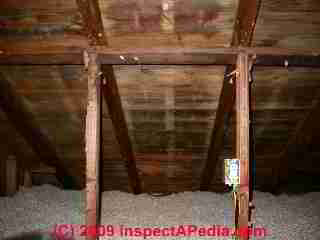 Is trapped mold present at all?
Is trapped mold present at all?
First, we don't know whether mold is present on mating wood surfaces such as between floor joists and subfloors, without destructive inspection to determine that presence as well as its extent.
We can inspect for mold between layers of subfloor or between subfloor and finish flooring by making test cuts from the underside of such surfaces, described at Photo Guide to using a round hole saw.
Our photograph of black mold on roof sheathing in an poorly-vented attic (left) displays a diagnostic history of the building, its moisture, and its attic mold. The vertical white stripes between areas of black mold on roof sheathing mark the location of previous wood framing that was removed (the roof was re-framed).
Because the light stripes mark areas where attic mold had not grown, we can see without doubt that the potential mold trap between the upper surface of the (now removed) rafters and the under-side of the roof sheathing (the white stripes) was precisely where attic mold did not grow.
The explanation of these white stripes on roof sheathing gives insight into the probability that troublesome mold growth is likely to be present or absent between the surface of a rafter or joist and the sheathing or subflooring that is attached to it.
An understanding of the moisture source and the moisture or water movement path in a specific building allows us to estimate the chance of hidden mold in the mating surfaces of wood framing and sheathing.
In this attic the moisture source was the building below. Poor attic venting trapped warm moist air in cold weather, leading to condensation on the exposed attic surfaces. Because the mating surfaces of rafter upper-sides and roof sheathing under-side were not exposed to attic air and attic condensation, the risk of mold formation on those mating surfaces was much less.
Are the Typical Quantity & Mobility of Trapped Mold on Wood Surfaces a Risk to Building Occupants
Unlike large mold reservoirs found in building wall cavities on the cavity side of drywall or in building insulation (these can be a problem in some buildings as air moves in and out of building cavities), mold trapped on mating surfaces such as between floor joist tops and subfloor undersides is very unlikely to be a hazard to building occupants.
We explain this view in more detail below. If however the mold is a species harmful to wood, causing rot and structural damage, further steps might be needed to protect the building.
For an example of mold harmful to buildings
see MERULIPORIA HOUSE EATING FUNGUS.
Field Experience Inspecting & Testing Mold on Inaccessible Mating Building Material Surfaces
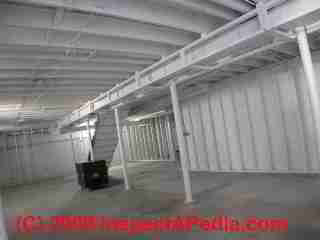 Trapped mold not detected in building air, surface, or dust samples: We have studied this problem in a number of catastrophic mold cleanup projects where in early years people believed it was appropriate to disassemble such framing to expose the hidden surfaces.
Trapped mold not detected in building air, surface, or dust samples: We have studied this problem in a number of catastrophic mold cleanup projects where in early years people believed it was appropriate to disassemble such framing to expose the hidden surfaces.
Later we inspected and measured buildings where, for example, a subfloor was left intact, cleaned on all exposed surfaces, but with no attempt to remove subfloor to clean the contact area between the subfloor and the tops of floor joists.
The areas were thoroughly cleaned and thoroughly treated with a fungicidal sealant. In our field and lab investigations since 1986, where mold removal/cleaning and sealants were properly performed and applied, subsequent field tests have not detected mold spores nor other particles entering the building from those locations.
Correcting the cause of mold reduces the risk of further growth of trapped mold
If there was mold growth between a sill plate and subfloor, but the building is now dry, which is highly likely in a dry climate a year after dry-in of the building (use a moisture meter with pin sensors and/or a radio-signal type such as the Tramex™), there will be no measurable movement of mold spores or particles out into the building air from those spaces, regardless of whether you caulk or not.
That has been my field experience with carefully instrumented measurements, including using a vacuum pump to try to pull particles out of such areas - there is just not sufficient air movement in and out of such tight spaces.
Harmfulness of trapped mold may be unknown
Furthermore, seeing "mold" on the bottom of sill plates does not tell us anything about whether or not the mold is harmful or cosmetic - some cosmetic molds enter buildings at the time of construction, already present on wood. Nor does such an inspection indicate the possibility of such spores entering the living area.
Mold anxiety may lead to unnecessary mold cleanup or sealant costs
We realize that leaving "mold" in place even in on sealed surfaces is uncomfortable for people who have already some reason for feeling anxious about a building. Think of it like seeing a few small knots in a 2x4 wall stud. If the stud is able to perform its structural duty, few experienced builders would insist that only clear lumber (free of knots or other cosmetic defects) be used to frame a building.
The trapped mold may be blamed for other, more serious harmful mold or allergen reservoirs
If you continue to have an allergic reaction to such a building, we would suggest that you or your mold expert look for a problem mold or other particle reservoir that has not yet been identified, such as moldy insulation that looks "clean"
Future mold risk in buildings where mold cleanup has occurred
Finally, even after a building is inspected and tested for mold and allergens by a well qualified expert (if such testing is risk/cost justified) that is absolutely no guarantee against a future mold problem.
Proper construction in many details (roofing, insulation, ventilation, plumbing, site drainage, choice of materials, installation details), must be supplemented by proper building maintenance (leak prevention, rapid response to leaks and water entry) to avoid a future mold problem.
See MOLD PREVENTION GUIDE for detailed advice on prevention of mold contamination in buildings.
To evaluate the leak and moisture history of your building,
the overall overall building risk for problematic mold contamination is discussed
When to Hire a Professional to inspect or test for mold?
MOLD / ENVIRONMENTAL EXPERT, HIRE ? helps consumers decide if it’s appropriate to bring in an mold professional - someone without conflicts of interest and who does not themselves offer mold cleanup or remediation services.
If there seem to be particularly high risks (building history, what you see, complaints or health risks of occupants) it might be appropriate to hire an expert
To Do your own sampling of surfaces or dust for evidence of problematic mold
see MOLD TEST KITS for DIY MOLD TESTS, a detailed procedure that describes how to collect DIY samples of what you see (you wont' address hidden mold in insulation or in building cavities by this method) using tape sampling.
- FIND MOLD in BUILDINGS, HOW TO gives advice on how to look more carefully at the building yourself
- MOLD DETECTION & INSPECTION GUIDE how to look for mold
- MOLD APPEARANCE - WHAT MOLD LOOKS LIKE what mold looks like, the appearance of mold on building surfaces
- MOLD APPEARANCE - STUFF THAT IS NOT MOLD stuff that is not mold - but is sometimes mistaken for problematic mold contamination - save your money
- USING LIGHT TO FIND MOLD how to use your flashlight to do a better job of looking for problem mold in buildings - proper aiming of the flashlight lets you see light colored, hard to spot, but potentially harmful mold contamination on surfaces.
What about "killing" the hidden mold in place using bleach (see MOLD CLEANUP with BLEACH) heat (mold pasteurization),
ozone (see OZONE MOLD / ODOR TREATMENT WARNINGS) , or tenting and gases?
Heating mold to pasteurize it or using other mold killing methods is pretty much junk science sold by companies preying on consumer mold fear, as is "killing" it by any process since many particles remain allergenic or toxic, live or dead.
See MOLD KILLING GUIDE for an explanation of why mold killing attempts are usually a costly mistake.
OPM: Some Consultants Spend Other People's Money to Reduce Risk For the Consultants, not for the Clients
 With this as many topics, even smart people but with no actual field test data to support a view, construct mental models of what they think is happening (yet without a single fact nor shred of evidence) and give aggressive cleanup advice accordingly.
With this as many topics, even smart people but with no actual field test data to support a view, construct mental models of what they think is happening (yet without a single fact nor shred of evidence) and give aggressive cleanup advice accordingly.
This approach is especially dangerous when the advice suffers what we call the "OPM" problem: that is, Ms. X, the consultant give advice that is safest for her (because the client cannot possibly complain in the future that her advice was not aggressive enough), because the safest (for her) advice does not cost her a dime - the client is the one who pays for the sometimes extreme measures that are suggested.
Consultants who offer OPM-based advice simply playing it safe and they are not earning their fee.
Our photograph (above left) shows extensive demolition performed to remove problem mold on floor framing and subflooring in an older home.
In this case the combination of multiple layers of moldy subflooring and flooring combined with a cost comparison of alternative approaches indicated that it was actually less costly to remove the subfloor and clean the joists than to leave the subfloor in place. In other buildings and circumstances it is reasonable and more economical to leave the subflooring in place.
Mold "Trapped" Between Wooden Building Material Surfaces - not readily accessible for cleaning without costly measures
The following questions were sent to InspectAPedia.com and suggested this article:
- Occupant sensitivity to mold or other allergens
I have been building a house in the mountains of New Mexico for quite awhile and have undergone a lot of difficulties with the process. I have an allergic and chemically sensitive condition and was attempting to build a healthful house. I have put everything I have into this house and my family and friends have contributed all they could too. I want to do the best thing, but not over-react. - Building leak history and hidden mold risk
While the house was being framed, it rained heavily. Water would sit up against the sill plates even though I would try to sweep the water out every day.
The framing process was slow so this went on for too long. The framing of the house developed some molded areas, so I had most of it sanded off at fairly high expense. Recently, I had a couple of plates cut out that went across doorways and found that the bottoms of the plates were blackened.
I dropped a section of the plate off to someone who deals with mold issues and he said it was mold on the bottoms of the plates. - Current building conditions affecting mold risk
he house has been dried-in for over a year now and the exterior is well waterproofed. I have not done the insulation or interior walls yet. - Other risks due to hidden trapped mold between wood surfaces?
The person who deals with mold who saw the plate said that he did not think I had molds that would compromise the structure, but there could conceivably be some toxic molds.
He said the more I pursue it however the more I would need to disclose if I sell the place and just ignoring it was a course to consider. - Opinions of "mold experts" about the mold risk in the building
When I had talked to him earlier, he did not express much concern about mold being on the bottom of the sill plates and said that I could just run a bead of caulk around it. He said that it was just important that the wall stay dry.
After looking at the wood, he sounded more concerned. He said that it might not be a problem, but sounded far from certain. I have talked to builders and gotten differing views on how bad and/or abnormal the situation is.
The project manager who was over-seeing the building of my house at the time said most of the time when he takes up sill plates in doorways they are blackened on the bottom. Another builder said that is not usual. - Goofy mold killing proposals?
we found some information on the web about companies that "pasteurize" mold by heating up the building (to 150 degrees). I talked to a representative from a company that does that process and he said that mold typically develops during framing if it rains and he did not see mold under the plates as a big problem and suggested I do nothing.
If this is a relatively normal thing, I may choose to do that. The person who deals with mold said it is not usual to have mold under the plates and that someone would normally tent a house if there was rain while framing. I have never seen that done in my area and it would be very difficult with the winds here if it could be done at all.
It was very unfortunate for me that the rains were so heavy at the time of the framing and I believe there were inadequacies in the framing process. - What do you think about the process of heating the house
up to 150 degrees for enough time to at least reduce the amount of viable mold and then sealing around the inner edges of the plates to keep spores from entering the living space?
The companies that do this are not located in New Mexico, but one representative said I could do it myself with construction heaters and that he would advise me on how to do it.
I have been wondering if there is some way to just heat up the sill plates since I have sanded most of the mold that was on the rest of the framing.
I have seen ads for something called a dry vapor steam cleaner that can kill mold, but I don't know if it could penetrate under the plates enough. The water managed to penetrate however (even though there are beads of caulk under there).
I have also considered trying to force some borate solution under the plate. we are wondering if you think Concrobium would be helpful to keep the mold contained under the plate. - Simple trapped mold remedy?
It has been suggested to me that a bead of caulk on the interior of the sill plate (as suggested by the mold consultant) would just hold in any moisture that might develop under the plate and make the situation worse. But exterior to the plate and exterior sheathing there is 3 inches of 2 lb. foam and I have been told that the high density foam keeps the dew point away from the inside of the wall so there may not be appreciable condensation in the wall.
The exterior sheathing has two layers of Tyvek, one of which is stucco wrap which is supposed to keep condensation from building up under the stucco. I don't know if condensation is likely to occur between the slab and the plate. There is a vapor barrier under the slab. Most of the house is fairly high up from grade.
Inspecting Multiple Layers of Flooring & Subfloors or Wall Studs & Sheathing for Hidden Mold
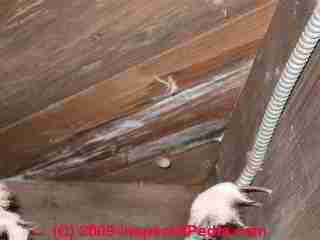
Our two photographs demonstrate a procedure we use to inspect for evidence of high levels of mold trapped between layers of flooring and subflooring in a building.
Detailed suggestions for deciding when such inspections are appropriate and how to conduct hidden mold in flooring are located in a separate article:
HIDDEN MOLD in FLOOR / SUB-FLOOR.
When to Make Strip Cuts to Look for Hidden Mold in Building Ceilings or Walls
When there is an ongoing building complaint that makes us suspect hidden leaks or mold, if we strongly suspect a hidden mold problem but have not found its precise location, on occasion it is justified to make a "strip cut" across multiple wall studs or ceiling joists, exposing multiple wall cavities.
What makes a lot of sense sense is to study the building carefully to decide on the building points at most risk of having been wet from leaks due to construction details or other site observations. That's where one would make a test cut.
Small amounts of mold can be removed simply by cleaning or removing infected materials, something most homeowners can handle -- but see the Warning Notice at the end of this article. Some mold species can make you sick.
How to Identify Hidden & Visible Molds that are Cosmetic or Harmless, or Other Low-Risk Molds
Cosmetic-only Ceratocystis/Ophistoma bluestain mold is shown on the floor joists in the new construction framing in the photo just above.
This is a harmless, cosmetic-only mold that does not damage the lumber and is not a pathogen for humans. Here's a good example of the observation that not all "black mold" is "toxic black mold". It will be totally hidden when the ceiling drywall is installed.
Detailed advice about how to determine by visual inspection alone whether or not you're probably looking at one of these common framing lumber cosmetic molds is at our
Photo Guide to COSMETIC MOLDS
...
Reader Comments, Questions & Answers About The Article Above
Below you will find questions and answers previously posted on this page at its page bottom reader comment box.
Reader Q&A - also see RECOMMENDED ARTICLES & FAQs
On 2019-05-04 - by (mod) - how to get rid of mold in wall cavity space later filled with foam insulation
Rod:
What's the mold actually growing on?
Exposed OSB - not intended for permanent exposure to the weather - can be cleaned using either simple cleaners, followed by drying and sealing with a suitable coating, or more aggressively with media blasting (not normally justified unless for cosmetic reasons)
But the underlying cause of mold growth is what needs to be addressed: leaks, water, moisture traps, lack of sunlight - of which you'd focus on fixing any leaks and weatherproofing the the exterior.
If there was mold growth on the surfaces of OSB sheathing that has now been covered by foam insulation, there is no economical way to remove the mold.
Since demolition and reconstruction of foam-filled exterior OSB-sheathed walls would be very costly, I'd want some more thorough investigation before considering such demolition work necessary.
- is there any evidence by odor or MVOC testing that the wall cavities are releasing mold MVOCs (or spores though that's far less likely) into building air?
- have test cuts been made to confirm the severity of and extent of mold contamination?
- has the cause of mold growth been determined and fixed?
- are we sure that the mold genera/species on the OSB are harmful? There's a small chance that the mold was cosmetic.
See COSMETIC MOLD, RECOGNIZE
On 2019-05-02 by Rod
How to eliminate mold from exterior osb walls that have closed cell spray foam as insulation on the inside
This Q&A were posted originally
at MOLD CLEANUP - WOOD FRAMING & PLYWOOD
On 2019-02-25 by (mod) -
Moldy drywall or sheetrock and insulation that was wet need to be removed and the framing cleans and the new materials installed.
On 2019-02-25 by Mary Lind
Insurance claim. Tree fell, roof crushed. 1 ceiling fell, then tile was removed in 4 other rooms so all ceilings could be replaced. There is mold on sheetrock that was located behind tile.
Does that material need to be treated or replaced before new ceilings are installed? Do I need to have it tested? I dont want to have a health problem later.
On 2018-10-05 by (mod) -
I would not remove the walls and flooring just because of remaining mold between the under-side of the wall sill plate and the upper side of the subfloor.
I just don't feel it's likely to be cost justified - assuming there is no other reason to remove it such as the presence of rot or structural damge. I would clean all the available surfaces, dry everything thoroughly, and stop there.
The remaining mold reservoir in that small enclosed area - assuming in your case it's probably just a few linear feet, if kept dry, is not likely to produce a detectable release of problem mold spores into the occupied space.
I would hesitate to try sealing the joint between sill plate and floor with caulk or other sealant - which is tempting, because I suspect you'd be trapping moisture in that very slow to dry area, inviting eventual rot.
On 2018-10-05 by Carolyn
My water line to my refrigerator started leaking, for how many days I don’t know. My closet is located behind the wall where the refrigerator sits. My closet has had carpet covers floors si I didn’t notice until the carpet was saturated. I have remover the carpet and drywall.
Some what appears to be black mold was between the walls and in two corners of the closet. I have used the bleach and water solution, but still notice black mold between the floor which is compressed wood and the 2x4s. Can I illuminate this by pouring the peroxide solution and allowing it to run between or must I remove the walls and flooring.
On 2016-09-03 by Anonymous
If there is surface mold there can certainly be mold in building cavities: walls, ceilings, under floors not slab on grade; I'd choose some most-suspect areas for judicious test cuts.
On 2016-09-03 by Janice
We are in the process of purchasing a foreclosed home that has been sitting in Florida for seven years with no Airconditioning. The inspector found yellowish surface mold on walls, cabinets, and floor boards. The floors are wood. They don't appear moldly. The entire place has a high moisture content. Should we be concerned about mold beneath the wood floors? There is bucking in one area, but it is not discolored. It is below an air vent. Thank you.
On 2016-02-06 by (mod) -
Kevin
I would be surprised if the mold trapped between the upper side of a 4" wide beam and the ceiling above would explain a mold smell, but your test argues that I'm wrong.
My suggestion: when the ceiling and beams are very dry (wood moisture below 18%, and 12% or lower is better) then seal the juncture of beam to sealing along either side with a small, well-bonded sealant either clear or color matched or paintable depending on the surrounding finished surfaces.
Keep in mind that in the future if you have leaks INTO the sealed space we're inviting rot.
On 2016-02-04 by Kevin
I am sure I have hidden mold sitting on the top side of exposed 4x10 wood beams in the ceiling. House is Mexican style with wood beams supporting a flat concrete ceiling. Ceiling leaks have been fixed but moldy smell persists. During leaks, water would sit on the top hidden surface of the beams in the crack between the beam and the clay ceiling tiles.
Other water would drip onto the floor. House has been dry for 2 months since leak repair and humidity is low through use of dehumidifier.
With the help of a ladder I can stick my nose into the offending crack and smell the Mold. As a test, I even sealed off the ceiling with poly and carefully taped the edges to ensure no air leakage from the ceiling into the room. Guess what, smell disappeared immediately. After one week I had to take the poly down due to asthetic reasons. Smell returned immediately.
So how can I fix this problem? Maybe poly the ceiling and apply drywall? Maybe give it more time to dry? Cant remove the beams or concrete roof will fall down. Maybe apply caulking in the crack between wood beam and ceiling tile to eliminate airflow. That would seal in the mold. Is that a good idea?
On 2015-09-02 by (mod) -
Kudos for a condensed question
IMO NO biocide is a good substitute for proper cleaning of clean-able surfaces and for removal of items that can't be cleaned such as moldy drywall and wet insulation.
See FUNGICIDAL SEALANTS by searching InspectApedia.com and you'll read details.
On 2015-09-02 by Ann
Just had flood from leaves clogged in drain on roof....had mold inspection ..have dangerous mold....I am very chemically sensitive...remediiator will use a prod I suggest
Soo which biocides or fungusides r the safest to use as far as out gassing for longer than three months...
and what to use on wood framing under roof.....
Any help woul b appreciated.....I research everything I can ...but alot to do in one day
...
Continue reading at HIDDEN MOLD in OTHER PLACES or select a topic from the closely-related articles below, or see the complete ARTICLE INDEX.
Or see these
Recommended Articles
- BLACK COSMETIC MOLD - not all black mold is harmful
- FUNGICIDAL SEALANT USE GUIDE - sprays and sealants used after proper cleaning reduce further risks
- HIDDEN MOLD in CEILING / WALL CAVITY
- HIDDEN MOLD in FLOOR / SUB-FLOOR - mold trapped between layers of flooring?
- HIDDEN MOLD in FRAMING / SHEATHING - other places where you may find "trapped" mold contamination
- HIDDEN MOLD, HOW TO FIND - home
- MOLD CLEANUP, BLEACH - not an adequate mold remediation approach
- MOLD CLEANUP - WOOD FLOORING - how to remove mold from wood flooring surfaces
- MOLD CLEANUP - WOOD FRAMING & PLYWOOD
- MOLD / ENVIRONMENTAL EXPERT, HIRE ? - when do we need to hire an experty?
- MOLD REMOVAL, MEDIA BLASTING - good approach for irregular or hard-to-clean surfaces
- SIDING, WOOD CLEANERS, STAINS, PAINTS how to remove stains on siding & how to choose the proper paint or stain coating
- TEST CUTS for MOLD in BUILDING CAVITIES - look for mold in inaccessible areas
Suggested citation for this web page
HIDDEN MOLD in FRAMING / SHEATHING at InspectApedia.com - online encyclopedia of building & environmental inspection, testing, diagnosis, repair, & problem prevention advice.
Or see this
INDEX to RELATED ARTICLES: ARTICLE INDEX to MOLD CONTAMINATION & REMEDIATION
Or use the SEARCH BOX found below to Ask a Question or Search InspectApedia
Ask a Question or Search InspectApedia
Questions & answers or comments about mold traps: mold that may be hidden between layers of building materials.
Try the search box just below, or if you prefer, post a question or comment in the Comments box below and we will respond promptly.
Search the InspectApedia website
Note: appearance of your Comment below may be delayed: if your comment contains an image, photograph, web link, or text that looks to the software as if it might be a web link, your posting will appear after it has been approved by a moderator. Apologies for the delay.
Only one image can be added per comment but you can post as many comments, and therefore images, as you like.
You will not receive a notification when a response to your question has been posted.
Please bookmark this page to make it easy for you to check back for our response.
IF above you see "Comment Form is loading comments..." then COMMENT BOX - countable.ca / bawkbox.com IS NOT WORKING.
In any case you are welcome to send an email directly to us at InspectApedia.com at editor@inspectApedia.com
We'll reply to you directly. Please help us help you by noting, in your email, the URL of the InspectApedia page where you wanted to comment.
Citations & References
In addition to any citations in the article above, a full list is available on request.
- Thanks to reader(anonymous) for suggesting clarification of text on the topic of trapped hidden mold in buildings, August 25, 2009 - discussing Mold under sill plates
- In addition to citations & references found in this article, see the research citations given at the end of the related articles found at our suggested
CONTINUE READING or RECOMMENDED ARTICLES.
- Carson, Dunlop & Associates Ltd., 120 Carlton Street Suite 407, Toronto ON M5A 4K2. Tel: (416) 964-9415 1-800-268-7070 Email: info@carsondunlop.com. Alan Carson is a past president of ASHI, the American Society of Home Inspectors.
Thanks to Alan Carson and Bob Dunlop, for permission for InspectAPedia to use text excerpts from The HOME REFERENCE BOOK - the Encyclopedia of Homes and to use illustrations from The ILLUSTRATED HOME .
Carson Dunlop Associates provides extensive home inspection education and report writing material. In gratitude we provide links to tsome Carson Dunlop Associates products and services.


